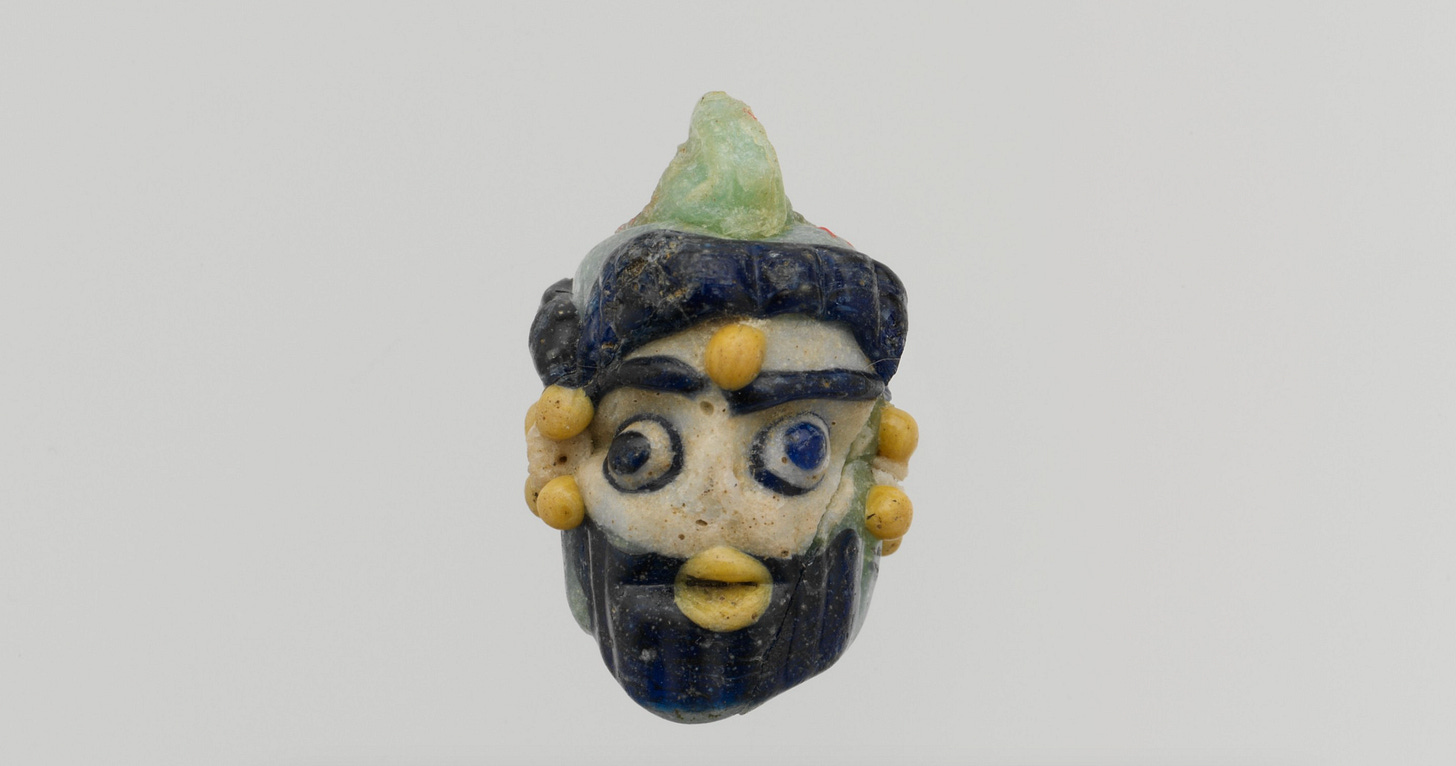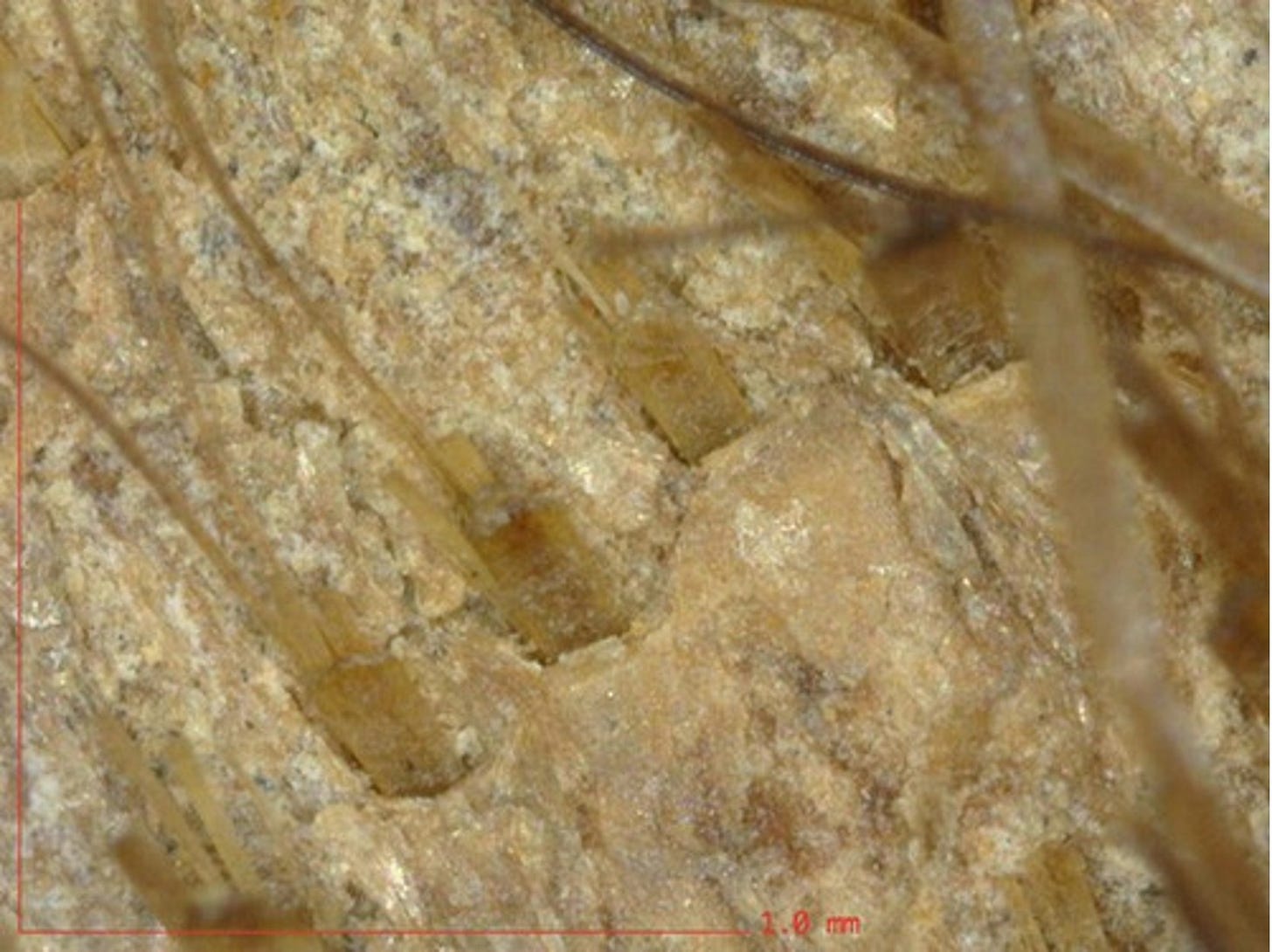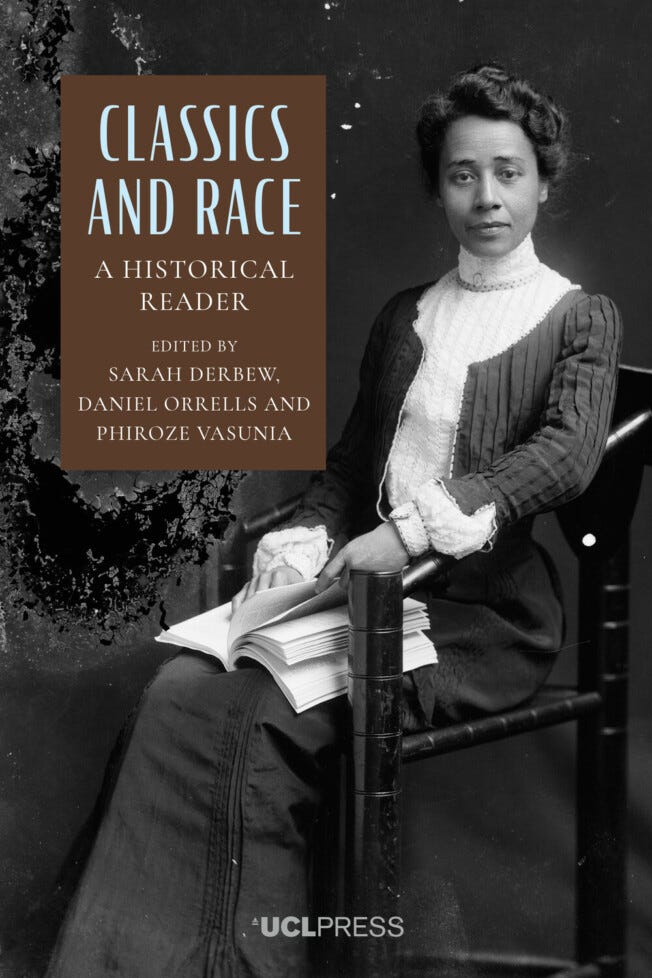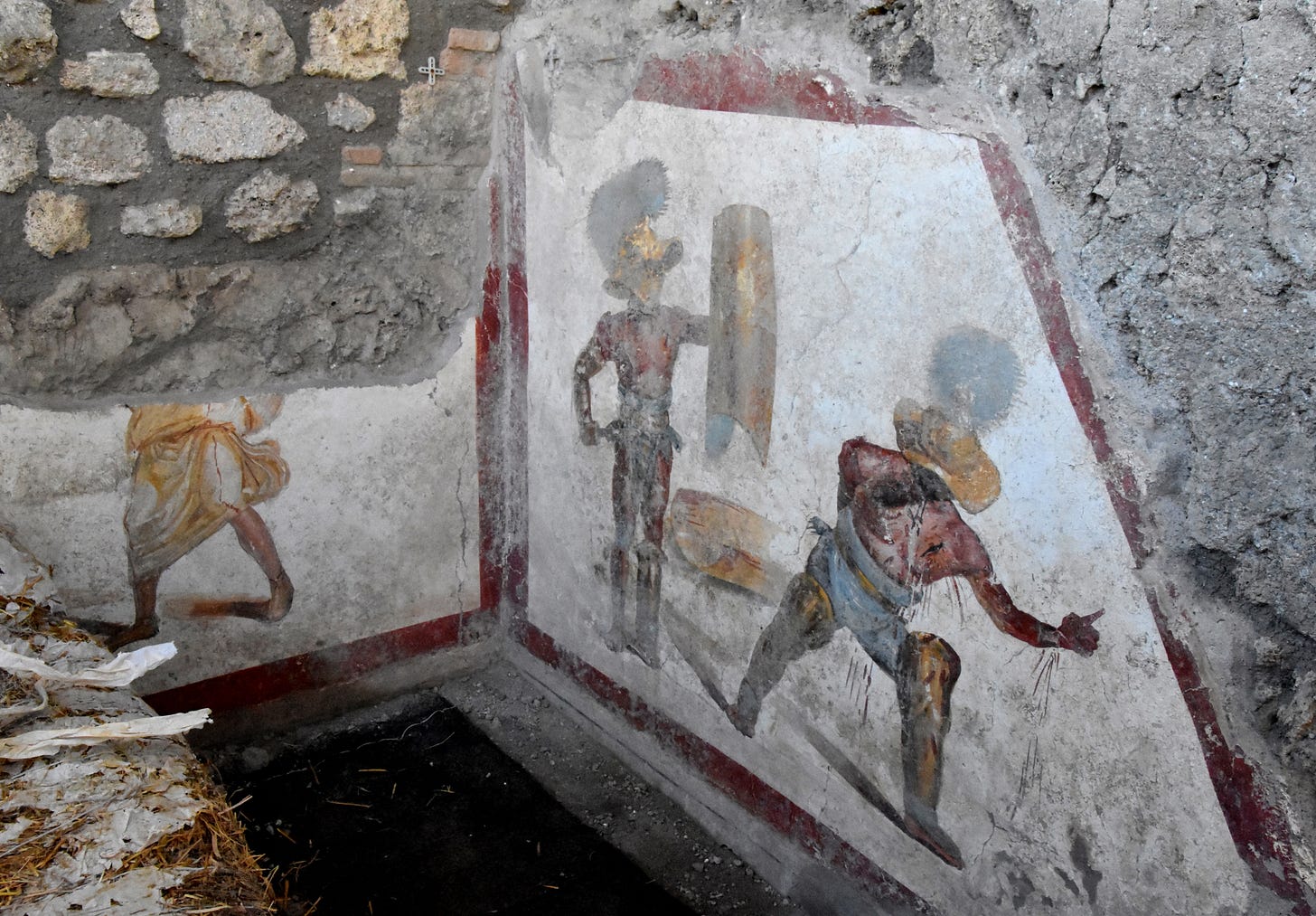Pasts Imperfect (5.1.25)
Slavery & the Economy of Pompeii, Inequality in Ancient Rome & Han China, Classics & Race, Finding the Phoenicians, Sealskin Manuscripts, and Much More

This week, a new open access article by ancient historian Seth Bernard looks at the roles of slavery and inequality in the economic prosperity of Pompeii. Then, inequality in Ancient Rome and Han China, ancient atlatls near the Mexican-US border, a new reader on Classics & Race, the lushness of the ancient Sahara, finding the Phoenicians, sealskin manuscripts, Medievalists of Color speak out in support of Palestine, the demise of the Institute for Museum and Library Services, new ancient world journals, and much more.
“Slavery, Prosperity, and Inequality in Roman Pompeii”: An interview with Seth Bernard
This is a short interview with Prof. Bernard regarding his new, open access article on “Slavery, Prosperity, and Inequality in Roman Pompeii” in the journal Past & Present. In it, Bernard suggests that “quantitative and statistical tools allow us to evaluate the place of slavery in an early economy, using Roman Pompeii as a case study.” By using a statistical model to overcome uncertainties inherent in the archaeological and literary evidence, he ultimately argues “with a high level of certainty that the prosperity of Pompeii was built in large part upon enslaved labour, which is likely to have formed the largest single source of income for the city’s economy (45).” His modeling suggests that enslaved persons likely contributed between 50 and 75 per cent of the total economy of the city. Pasts Imperfect spoke to Bernard about the article and about its modern resonances.
PI: In the article, you use modern income inequality metrics like the Gini coefficient in order to measure inequality at Pompeii. The United States sits at around 0.41 right now and you favor a range of around 0.67–0.73 for Pompeii (note that South Africa sits at the extreme of 0.63). Why is it important to know about and measure inequality in antiquity?
First, I would be clear on what sort of inequality we are talking about. There were many forms of inequality in antiquity, just as today. When economic historians talk about inequality, they are talking about distributions of wealth and income. The measurement of such economic inequality is important because it takes us from large metrics like GDP or economic size more directly to human outcomes. If a society’s economy is really productive, it can matter next to nothing for people within that society if they are not able to enjoy a share of the product. So, economic inequality and wealth distribution can help us move from big, often abstract measurements into the critical topic of individual outcomes and wellbeing. Meanwhile, anthropologists and archaeologists have largely followed economists in thinking about inequalities in terms of wealth, but they have also used wealth as a proxy for social and political hierarchies within historical societies.
I think allowing for different forms of inequality in the Roman world makes things all the more fascinating. We know that there were substantial legal inequalities in terms of access to rights, most pertinently in the distinction between free and slave. We also know that the Roman Empire and its economy contained inequalities of wealth. Sometimes those inequalities overlapped — most Roman slaves lived terrible lives, deprived almost entirely of the wealth they themselves produced. But we also find rich slaves and poor free Romans, and we even find some free Romans selling themselves into slavery. So, the complexities and intersecting inequalities of the Roman world make the topic really interesting and worth investigating.
PI: What impact does knowing about the extreme levels of ancient inequality then have on our understanding of the socio-economic implications of increasing inequality today?
We are still living in the shadow of the 2008 financial crisis and the increasing recognition that the distribution of wealth in our own world seems disadvantageous to very many people. The 99% movement really put this topic front and centre, and for good reason, as access to wealth translates in very many cases in our world to access to other vital aspects of our lives. And now here we are right now with the wealthiest person in the world having gotten ahold of politics, so this topic isn't going away—it feels in some ways even more vital in the current moment. As a historian, I stress that to say that we are living in a time of relatively disproportionate wealth is ultimately to make a historical claim: it’s about the relationship of present to past levels of inequality. So, figuring out how unequal past societies were and doing so in a way that allows us to compare past and present becomes all the more urgent for informing our own senses of economic unfairness and disenfranchisement.
PI: What do you see as the main difference between creating and appropriating wealth, and how do Romans excel at the latter?
This is really a question to consider once we admit slavery had a role in Roman economic growth. You can grow an economy in many ways, but one big way to do so is by raising the marginal production of labor, which is to say, by having people make more of whatever they make. How do people become more productive? Well, you can do that through specialization or through technology — these are the core ingredients of economic growth in big theories of Adam Smith or Joseph Schumpeter respectively. Roman historians have lately emphasized the role of institutions, which serve to protect trade and can encourage participation in markets. This was the classic idea of Keith Hopkins that Romans of the Empire needed to pay taxes in cash, and so they sought to participate in markets, and this encouraged greater trade. People also become more productive through training and what we call human capital formation, and I do think that human capital or skill was more consequential to the Roman economy than we have sometimes thought—Richard Saller has said this.
But it stands to reason that slavery presents another route to growth: you can make labor more ‘productive’ simply by giving workers less of what they produce, and that is what owning a slave permitted a Roman to do. We absolutely know that some Romans were making close calculations about how much food or other commodities their slaves received. Cato advised landowners exactly how much food to provide slaves and when. Was this sort of systematic appropriation of labor how some Romans increased their wealth? Suppose you were a Roman landowner who wanted to take up new opportunities to participate in markets in the wake of a more favorable institutional environment. Well, let us not forget that, in the Empire you were also probably a slave-owner.
Some historians like Peter Bang have talked about Rome as a predatory economy. What does that mean? Again, if we take it for granted that some Romans got rich, then the question is the source and nature of that wealth. It’s possible that Romans amassed more wealth because the Roman economy was overall more productive for some of the reasons I have noted. But it is also possible that Romans got rich in part or even mainly because they were appropriating the wealth of others. This makes sense macroeconomically: think of Romans during the Republic sacking Greece and Asia Minor and looting cities, and then taking wealth as well as slaves back home with them. Greece then looks poorer in the Early Empire while Italy looks rich. We might also think about this microeconomically: some Romans were getting rich while others in their households were enslaved and had little share of that wealth. I think overall Rome was good at appropriating resources because that is very much how empires work at a macroeconomic level. It’s important to think about that also at the level of households and slave-owners who may have been elaborating a sort of miniature version of the same process.
For more on slavery and inequality at Pompeii, we suggest reading work by Miko Flohr (all of it, but especially: ‘Quantifying Pompeii: Population, Inequality, and the Urban Economy’, in Flohr and Wilson [eds.], Economy of Pompeii); Sarah Levin-Richardson’s The Brothel of Pompeii: Sex, Class, and Gender at the Margins of Roman Society; and Silvia Martina Bertesago and Gabriel Zuchtriegel, The Other Pompeii: Ordinary Lives in the Shadow of Vesuvius (Naples, 2024), a catalogue to the exhibition of the same name (‘L’altra Pompei – vite comuni all’ombra del Vesuvio’ 15 Dec. 2023 to 15 Dec. 2024). For more on the “prison bakery” mentioned in the article, see:
Global Antiquity and Public Humanities
In Nature Communications, Guido Alfani, Michele Bolla and Walter Scheidel have a new article on “A comparison of income inequality in the Roman and Chinese Han empires.” The authors compare the level of inequality in the Roman Empire circa 165 CE with the Chinese Han Empire ca. 2 CE, as well as the Aztec Empire ca. 1492. They “find that the Han Empire was, overall, more unequal and extractive than the Roman Empire,” and argue that “higher inequality increased the potential for political instability and the collapse of empires.” Just wanted to note (per the numbers from the Congressional Budget Office) that between 1979 and 2021, the 12,000 households that make up the richest 0.01 percent of the U.S. grew “nearly 27 times as fast as the income of the bottom 20 percent of earners”—while the federal minimum wage has remained at $7.25 per hour for almost 16 years. Inequality, indeed.

Just 40 miles north of the Mexican-US border, archaeologists have uncovered and analyzed a 6,500-year-old hunting kit. Despite heavy looting, the cave site has yielded various tools used by hunters like an atlatl (spear-thrower) and a boomerang-type object. You can read about the atlatl in the Journal of Big Bend Studies.
What’s not to love about palaeogenetics? Researchers, including Nada Salem, an archaeologist at the Max Plank Institute for Evolutionary Anthropology in Leipzig, German, working in southwestern Libya have sequenced ancient DNA to find out more about what the Sahara was like around eight millennia ago. Spoiler alert: it was a lush, green savannah before it was taken over by the desert.
The return of the desert probably cut people off as water sources became scarcer. But the genetic isolation of the Takarkori women suggests that even when the Sahara was lush, it was still a barrier to travel. “It’s not easy for us to believe,” says Salem. “But this is what we found.”
In addition, there is also a new study attempting to trace the origins of Phoenician and Punic peoples using the aDNA of 210 individuals, of which “196 [are] from 14 sites traditionally identified as Phoenician and Punic in the Levant, North Africa, Iberia, Sicily, Sardinia and Ibiza, and an early Iron Age individual from Algeria” that ultimately led the co-authors to proclaim that “Punic people were genetically diverse with almost no Levantine ancestors.” Might we suggest a re-read of Josephine Quinn’s splendid In Search of the Phoenicians?

In manuscript news, it turns out that 12th and 13th century Cistercians from Clairvaux and associated Abbeys liked to bind their manuscripts in sealskins. An international team of bio-codicologists, lead by Matthew Collins, used ancient DNA analysis and electrostatic zooarchaeology by mass spectrometry (eZooMS), among other techniques, to identify the animal origins of these furry covers—suggesting rather extensive northern trade networks. Read their paper in Royal Society: Open Science and coverage in the New York Times and the Guardian.

Medievalist Cord Whitaker has posted the text of his talk from the Medieval Academy of America (MAA) meeting in Cambridge last month, which was boycotted by the Medievalists of Color (MOC) over the treatment of Palestinians in Gaza. You can read the full text here. His remarks on neutrality feel particularly important at this moment:
No, the Medieval Academy’s actions—or lack thereof—have not been neutral. Sure, they tried to be, but power has now been consolidated in the hands of those who are against humanism and humanity. When those are the conditions, then neutrality is no longer neutral. Neutrality is a vote in their favor…We are not neutral. We cannot afford to be. And I daresay, none of you in this room can afford to be either. I repeat: We are not neutral. Nor will we be moved.
The much anticipated Classics and Race: A historical reader, edited by Sarah Derbew, Daniel Orrells, and Phiroze Vasunia, has just been published online (open access!) and in print by UCL Press. It offers a chronological exploration of the relationship between classical texts and racist and anti-racist thought from the Kebra Nagast to the Letter from a Birmingham Jail.

The Demise of the Institute for Museum and Library Services (IMLS). DOGE’s purging of the NEH featured in our previous issue was presaged by its treatment of IMLS in late March. As of April 1st, all its staff has been placed on leave and its grants-processing has stopped. Like NEH, does a lot with a little, and like the NEH the cessation of its work will be broadly felt. The wide impact of the IMLS’s grant-making and research activities is evident in the strong bipartisan support it was enjoyed: it: Its activities and funding had been most recently reauthorized in the previous Trump administration by the Museum and Library Services Act of 2018 which passed the Senate by unanimous consent and the Republican House by a 303 vote margin.
The effects of the dismantling of the IMLS will be felt within academy--especially at smaller institutions--but the most pronounced effects will be on access to library resources for the broader public. IMLS funding supports state and regional resource-sharing networks facilitating interlibrary loan and licensing online resources. The end of its Grants-to-States program will severely curtail such services and make access to a range of library materials difficult if not impossible. The American Library Association and the American Alliance of Museums have both issued statements raising concern about these effects, and ALA and the American Federation of State, County and Municipal Employees (AFSCME) have gone to court seeking an injunction, as the filing claims “Congress is the only entity that may lawfully dismantle the agency, not the President and certainly not DOGE.”
Antiquity Journal Issues (by yaleclassicslib.bsky.social)
Bulletin of the American Society of Papyrologists Vol. 61 (2024)
Deimos: Zeitschrift für Antike Militärgeschichte Vol. 1 (2025) #openaccess
Emerita Vol. 92 No. 2 (2024) #openaccess
Geistes-, sozial- und kulturwissenschaftlicher Anzeiger ‒ Zeitschrift der philosophisch-historischen Klasse der Österreichischen Akademie der Wissenschaften, Vol. 159 (2024) #openaccess Borders Matter: Rereading the Rhine-Danube Limes and the End of the Roman Empire
Journal of Classics Teaching Vol. 26 , No. 51 (2025) #openaccess
Mélanges de l'École française de Rome - Antiquité Vol. 136, No. 2 (2024)#openaccess Les entourages et le pouvoir dans le monde romain aux premiers siècles de l’Empire
Mnemosyne Vol. 78, No. 3 (2025)
Sylloge epigraphica Barcinonensis: SEBarc Vol. 22 (2024) #openaccess
TAPA Vol. 155, No. 1 (2025)
thersites Vol. 20 (2025) #openaccess
Bochumer Philosophisches Jahrbuch für Antike und Mittelalter Vol. 26 (2023)
Centaurus Vol. 66, No. 1-2 (2025)
Epoché Vol. 25, No. 2 (2025)
Journal of the History of Ideas Vol. 86, No. 2 (2025) Context and Paratext: New Insights into the Early Modern Reception of the Greek Fathers
Journal of the History of Philosophy Vol. 63, No. 2 (2025) #openaccess NB Lea Aurelia Schroeder, “Plato on Object Perception (Theaetetus 184–87 and 191–96)”
Medicina nei Secoli Vol. 37 No.1 (2025) #openaccess
Micrologus. Nature, Sciences and Medieval Societies Vol. 33 (2025) #openaccess Power, Religion, and Wisdom. Orthodoxy and Heterodoxy in al-Andalus and Beyond
Philosophy East and West Vol. 75, No. 2 (2025) NB Laura P. Guerrero, “Buddhist Fundamental Ontology”
Archaeological Dialogues Vol. 30, No. 2 (2023) NB #openaccess Sabina Cveček “Select Enthrone, dethrone, rethrone? The multiple lives of matrilineal kinship in Aegean prehistory.” (discussion article)
Bibliotheca Orientalis Vol. 81, Nos. 3-4 (2024)
International Journal of Cultural Property Vol. 31, No. 3 (2024) Ukrainian Cultural Heritage Preservation
Reviews in Digital Humanities Vol. 6, No. 4 (2025) #openaccess
Zeitschrift für Orient-Archäologie Vol. 16 (2023) #openaccess
Currents in Biblical Research Vol. 23, No. 2 (2025)
Journal of Biblical Literature Vol. 143, No. 4 (2024)
Journal for the Study of Judaism Vol. 56, No. 2 (2025) NB Alexander Chantziantoniou “Are Εἴδωλα Idols? Probing a Lexicographical Trope”
Vetus Testamentum Vol. 75, No. 2 (2025)
Cahiers de l'Institut du Moyen-Âge Grec et Latin 93 (2024) Peter Abelard's Logic and its Network,
Early Medieval Europe Vol. 33, No. 2 (2025)
Revue Mabillon Vol. 35 (2024)
Lectures, Exhibitions, and Workshops
Friday, May 2nd at 4pm BST (11am EST), the online Material Digital Humanities seminar will feature Martina Filosa (Universität Köln), Usama Gad (Ain Shams, Cairo), and Gabriel Bodard (University of London) discussing “Making the Implicit Explicit: Digital editions of ancient text-bearing objects.”
The Medieval Academy of America will host a Premodernist Community Hour on Tuesday, May 6th at 1pm EST to discuss cuts to federal funding and their impact on scholarship.
On May 6, 2025 at 1-2 pm BST, Ahmed Shams will discuss “The conservation and re-use of ancient water systems in the High Mountains of Sinai Peninsula” for the EES online. Shams will address “the 20-year plus field-survey by [the] Sinai Peninsula Research (SPR),” and discuss “the climate change challenge at high-elevation heritage landscapes.” You can book attendance online for free here.









I also find it concerning that the Punic study didn't include any archaeologists from Tunisia or Algeria, especially in a paper claiming African ancestry was a "minority contributor" to Carthage, and uses worrisome terms like "ancestry mixing" which seems wildly close to "race mixing" to me. Seems like typical extractive/colonial science to me, and I am shocked and disappointed that no one seems to have taken a critical approach to it yet.